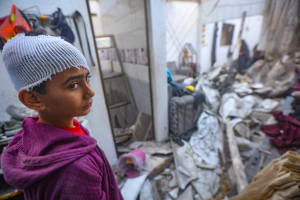After over a week of quiet, massive airstrikes return to Beirut after IDF warns residents to flee
Israel reportedly threatens to raze Dahiyeh in Beirut if Hezbollah targets its leaders again

After more than a week of significantly reduced Israeli strikes in the Lebanese capital, Beirut, the IDF launched a second consecutive overnight wave of strikes on Monday evening, specifically targeting Hezbollah’s financial institutions.
In a press briefing on Monday evening, IDF Spokesman Brig.-Gen. Daniel Hagari the Israeli Air Force (IAF) had struck over 20 targets connected to Hezbollah’s civilian institutions, most of them in the Dahiyeh district of Beirut.
“In the coming hours, we will continue to attack Hezbollah targets throughout Lebanon, including in Beirut in Dahiyeh,” Hagari warned.
#عاجل إلى جميع السكان المتواجدين في منطقة الضاحية الجنوبية وتحديدًا في المباني المحددة في الخرائط المرفقة والمباني المجاورة لها في المناطق التالية:
— افيخاي ادرعي (@AvichayAdraee) October 21, 2024
🔸حارة حريك
🔸برج البراجنة
⭕️أنتم تتواجدون بالقرب من منشات ومصالح تابعة لحزب الله سوف يعمل ضدها جيش الدفاع على المدى الزمني… pic.twitter.com/0HnTsJRXZ2
After the IDF’s Arabic spokesman issued several calls for the evacuation of Hezbollah sites in Beirut, Lebanese media reported that over a dozen Israeli airstrikes were carried out into the early morning hours of Tuesday throughout the capital.
The IDF later said it had struck underground infrastructure containing aircraft and ships, including the main base of Hezbollah's naval unit.
"The unit used the base as a central activity hub of the organization: Storage of fast vessels, conducting experiments and training for the organization's naval force. The unit's vessels are designed to attack Israeli Navy vessels, and naval and strategic targets in Israel's maritime space," the IDF stated.
Throughout the first months of the conflict, Israel refrained from conducting strikes in the Lebanese capital, where the Dahiyeh district, Hezbollah’s main stronghold, is located. A first exception came in January, when Israel eliminated top Hamas leader Saleh al-Arouri.
At the time, Hezbollah warned that Israeli strikes in Beirut were a “red line” that would cause attacks deep in the Israeli heartland.
Despite this, in July, Israel Defense Forces began an intense and continuous bombardment of strategic Hezbollah targets and top commanders after a Hezbollah rocket killed 12 children in the “Majdal Shams massacre.”
However, according to media reports, the Biden administration began pressuring Israel in recent weeks to stop its frequent attacks in Beirut and to give diplomatic efforts a last chance to reach a ceasefire.
Still don’t know why we’re operating in Dahieh? Watch this: pic.twitter.com/MUXqMbQQBH
— Israel Defense Forces (@IDF) October 21, 2024
Israel apparently disregarded the American request after a Hezbollah drone struck Prime Minister Benjamin Netanyahu’s private home in Caesarea on Saturday morning.
Israel also sent a message to Hezbollah that if it tried to assassinate Israeli leaders again, then Dahiyeh would be completely leveled, unnamed sources told the Saudi Al-Hadath news channel.
“The IDF has been taking apart the Dahiyeh in the last two days and this is also the main means of pressure to bring about a ceasefire under conditions favorable to Israel,” said Ynet News military analyst, Yossi Yehoshua. “And if this is what Hezbollah manages to produce in response, it has been severely harmed,” he added.
הרמטכ״ל, רב-אלוף הרצי הלוי קיים היום הערכת מצב וסיור בדרום לבנון עם מפקד פיקוד הצפון, אלוף אורי גורדין, מפקד אוגדה 98, תת-אלוף גיא לוי ומפקדים נוספים>> pic.twitter.com/6UTh6GcoMI
— צבא ההגנה לישראל (@idfonline) October 21, 2024
IDF Chief of Staff Lt.-Gen. Herzi Halevi visited soldiers in Lebanon on Monday, telling them, “We attack in Beirut, you take care of targets here – all this leads to retaliation against Iran, which finances and sends weapons here.”
Over the past 24 hours, the Israeli Air Force has struck over 230 terror targets belonging to Hezbollah and Hamas, most of them in Lebanon.
Among the sites targeted were three command centers of Hezbollah’s aerial system, Unit 127, responsible for launching drones.
In recent days, Israel’s ground troops continued their slow advance across southern Lebanon, killing terrorists in firefights and directing airstrikes, while locating and destroying battle compounds and large stockpiles of weapons and ammunition.
צה"ל תקף ביממה האחרונה יותר מ-230 מטרות טרור בשטח לבנון וברצועת עזה, בהן שלוש מפקדות של היחידה האווירית של ארגון הטרור חיזבאללה (יחידה 127) בעומק לבנון; חוסלו כ-15 מחבלים בתקיפת חמ״ל של חיזבאללה בדרום לבנון >> pic.twitter.com/s60Oruqob5
— צבא ההגנה לישראל (@idfonline) October 22, 2024
So far, the IDF said its troops eliminated seven brigade-level commanders, 21 battalion commanders and 24 company commanders of the Hezbollah terror group.
In addition, airstrikes hit some 3,200 Hezbollah targets, including hundreds of ammunition depots, hundreds of launchers, anti-tank missile posts, infrastructure and headquarters.
כוחות צה"ל ממשיכים בפעולות ממוקדות בגזרת לבנון, ובשיתוף פעולה הדוק בין כוחות אוויר מודיעין ואש, חוסלו עד כה 7 מפקדי חטיבות, 21 מפקדי גדודים ו-24 מפקדי פלוגות בארגון הטרור חיזבאללה>> pic.twitter.com/o82KlIjuX5
— צבא ההגנה לישראל (@idfonline) October 21, 2024
The IDF said that over 30 hostile drones were shot down in the past seven days, while Hezbollah also increased the rate and scope of its rocket fire against Israel.
On Tuesday morning alone, the group fired rockets at Haifa and its suburbs, the Tel Aviv area, Modi’in Illit in Samaria, as well as several towns in the northern Galilee.

The All Israel News Staff is a team of journalists in Israel.












